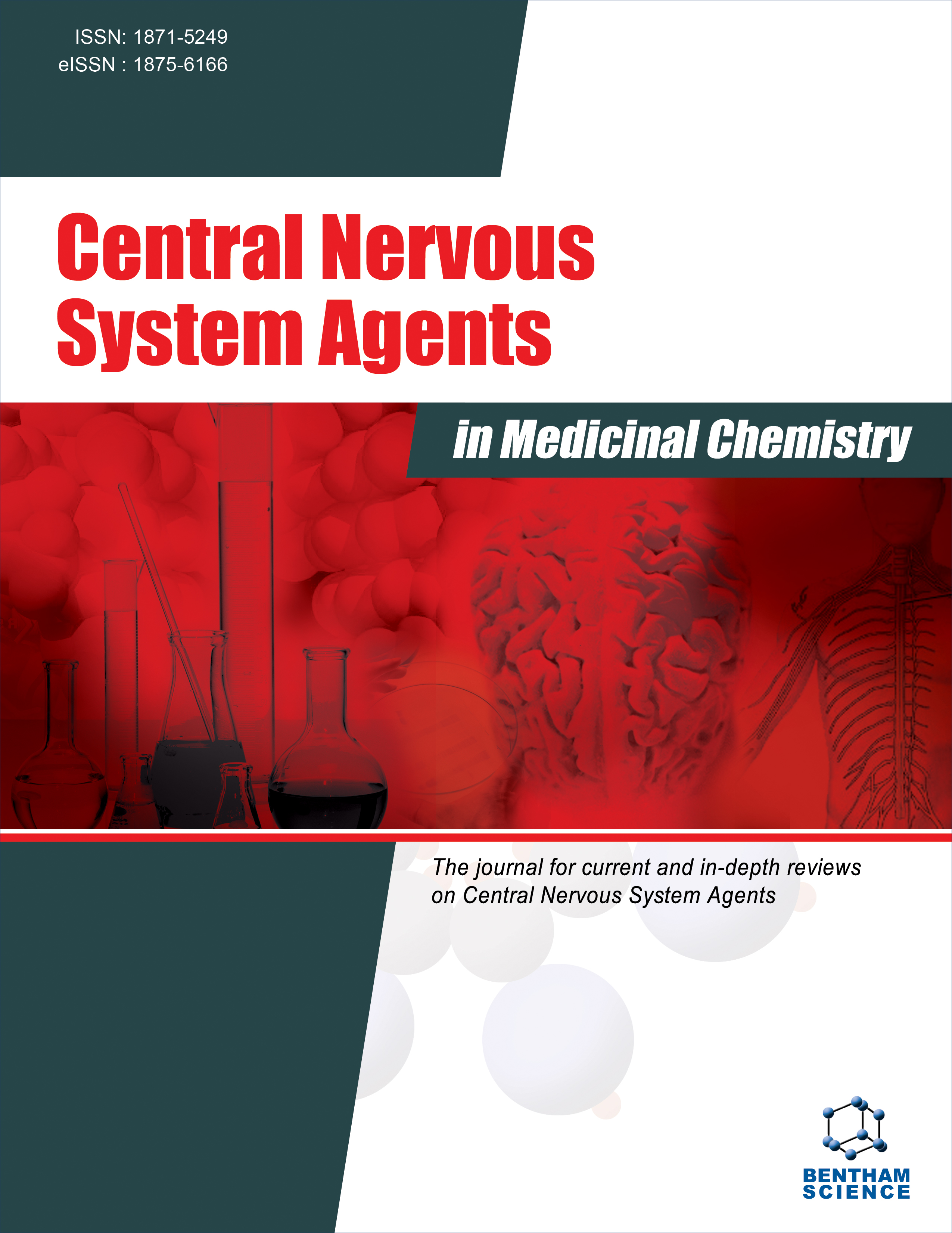- Home
- A-Z Publications
- Central Nervous System Agents in Medicinal Chemistry (Formerly Current Medicinal Chemistry - Central Nervous System Agents)
- Previous Issues
- Volume 11, Issue 1, 2011
Central Nervous System Agents in Medicinal Chemistry (Formerly Current Medicinal Chemistry - Central Nervous System Agents) - Volume 11, Issue 1, 2011
Volume 11, Issue 1, 2011
-
-
Editorial
More LessCentral Nervous System Agents in Medicinal Chemistry continues with its objective of bringing together the different perspectives of scientists with diverse backgrounds in chemistry, biology and pharmacology with the common goal of fostering the development of medicinal chemistry and its integration with growing disciplines in the field of medical sciences. With a careful selection of subjects and up to date reviews, Central N Read More
-
-
-
Use of STAT1 Inhibitors in the Treatment of Brain I/R Injury and Neurodegenerative Diseases
More LessAuthors: F. H. Ebner, E. Darra, S. Mariotto, H. Suzuki and E. CavalieriIn the etiology of brain injury associated to ischemia/reperfusion (I/R) and neurodegenerative diseases, a critical involvement of excessive activation of signal transducer and activator of transcription 1 (STAT1) and successive induction of iNOS expression has widely been evidenced. Any compound capable to down-regulate STAT1 activation seems to represent a new, promising anti-inflammatory drug. Among plant comp Read More
-
-
-
Genetic and Modifying Factors that Determine the Risk of Brain Tumors
More LessSome modifying factors may determine the risk of brain tumors. Until now, it could not be attempted to identify people at risk and also to improve significantly disease progression. Current therapy consists of surgical resection, followed by radiation therapy and chemotherapy. Despite of these treatments, the prognosis for patients is poor. In this review, we highlight general aspects concerning genetic alterations in brain tumors Read More
-
-
-
Elderly Patients with Migraine: An Open-Label Study on Prophylaxis Therapy with Levetiracetam
More LessAuthors: V. Pizza, V. Busillo, A. Agresta, A. Bisogno and A. CapassoIn the last years, the hypothesis that cortical hyperexcitability may play a role in the physiopatology of migraine led to the therapeutic use of some antiepileptic drugs. To evaluate the efficacy of levetiracetam as prophylactic treatment for migraine without aura in elderly patients. We performed a small open-label trial treating 13 elderly patients( 8F 5M) mean age 64.7 years (SD 3.4), range 60-72 years affected by migraine witho Read More
-
-
-
Neurogenic Drugs and Compounds to Treat CNS Diseases and Disorders
More LessNeurological diseases and related conditions affect an estimated 1 billion of individuals worldwide [1]. There is still no cure for neurological diseases and disorders, barely a few treatments more or less efficient. This mandates the design and development of novel paradigms and strategies, to discover and develop new treatments and cures for these diseases. Neurogenesis occurs in the adult brain of mammals primarily in two Read More
-
-
-
Newer Avenues for the Treatment of Leptomeningeal Carcinomatosis
More LessAuthors: Fausto Meriggi and Alberto ZaniboniLeptomeningeal Carcinomatosis (LC) refers to diffuse seeding of the leptomeninges by tumor metastases and is a rare presentation of solid tumors, particularly breast cancer, lung cancer and malignant melanoma in adults and hematogenous malignancies and primitive neuroectodermal tumor (PNET) in children. Recently, the incidence of LC has been reported to be increasing due to a longer overall survival obtained in patients Read More
-
-
-
p38 MAP Kinase Inhibitors as Potential Therapeutic Drugs for Neural Diseases
More LessAuthors: S. Yasuda, H. Sugiura, H. Tanaka, S. Takigami and K. YamagataMammalian p38 mitogen-activated protein kinases (MAPKs) are activated by various cellular stresses, as well as in response to inflammatory cytokines. In the central nervous systems (CNS), activation of the p38 MAPK pathway constitutes a key step in the development of several diseases, and the molecular mechanisms mediated by p38 MAPK signaling have been defined. Activation of this cascade releases pro-inflammato Read More
-
-
-
Synthesis and Screening of Substituted Thiosemicarbazone Derivatives: An Approach towards Novel Anticonvulsant Search
More LessAuthors: Priyanka Singh, Jainendra Jain, Reema Sinha, Abdul Samad, Rajeev Kumar and Manav MalhotraA series of thiosemicarbazones of halogen substituted benzaldehydes, benzophenone and acetophenone were synthesized using an appropriate synthetic route and characterized by thin layer chromatography and spectral analysis. The anticonvulsant activity of synthesized compounds was established in three seizures models which includes maximal electroshock (MES), subcutaneous pentylene tetrazole (scPTZ) induced seiz Read More
-
-
-
Properties and Potency of Small Molecule Agents for Treatment of Mycobacterium Tuberculosis Infections of the Central Nervous System
More LessTuberculous meningitis is caused by Mycobacterium tuberculosis, which is the bacteria that causes tuberculosis. This bacteria spreads to the brain from another site within the body. If untreated, tuberculous meningitis can be lifethreatening. Substantial brain damage can result from infection which results in mental impairment, motor paralysis, seizures, and abnormal behavior. This study presents the analysis of the effectiven Read More
-
-
-
Catatonia: A Narrative Review
More LessCatatonic syndromes involve a complex mixture of motor, behavioral, and systemic manifestations that are derived from unclear mechanisms. What is clear is that neurotransmitters, such as dopamine (DA), gamma-aminobutyric acid (GABA), and glutamate (GLU), are of major importance in the pathogenesis of catatonia and Neuroleptic Malignant Syndrome (NMS) and that serotonin (5-hydroxytryptamine [5-HT]) is crucial t Read More
-
Volumes & issues
-
Volume 25 (2025)
-
Volume 24 (2024)
-
Volume 23 (2023)
-
Volume 22 (2022)
-
Volume 21 (2021)
-
Volume 20 (2020)
-
Volume 19 (2019)
-
Volume 18 (2018)
-
Volume 17 (2017)
-
Volume 16 (2016)
-
Volume 15 (2015)
-
Volume 14 (2014)
-
Volume 13 (2013)
-
Volume 12 (2012)
-
Volume 11 (2011)
-
Volume 10 (2010)
-
Volume 9 (2009)
-
Volume 8 (2008)
-
Volume 7 (2007)
-
Volume 6 (2006)
Most Read This Month
Article
content/journals/cnsamc
Journal
10
5
false
en


